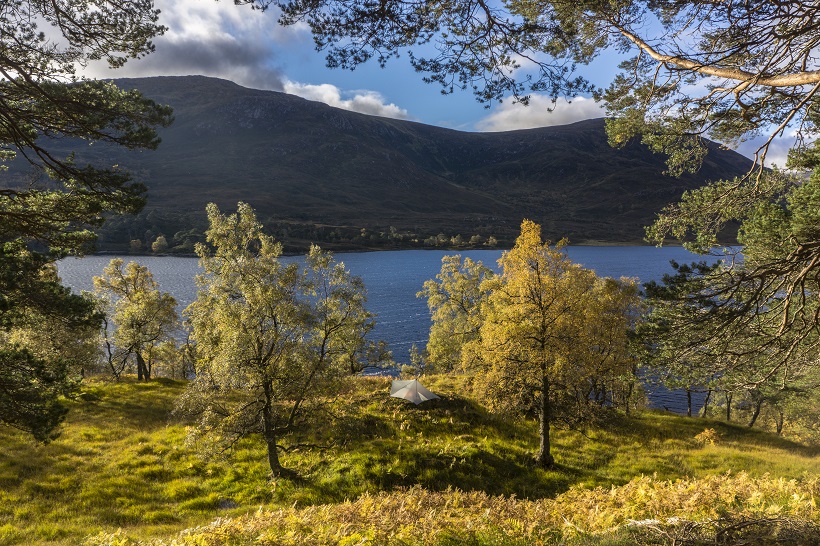Mini escapes in Scotland’s wild places – perfect to try in autumn when the landscape is at its most jaw-dropping.
Glen Affric
Situated in the North-Western Highlands Glen Affric offers a heady combination of altitude and aesthetics. For Munro-baggers the eight peaks that rise north of the glen can be climbed in a long two day trip. The best approach is from the car park at Chisholm Bridge by Loch Beinn a’Mheadhoin amongst the beautiful Glen Affric woods from where you can follow the often muddy track up Gleann nam Fiadh before turning north for the first Munro, Toll Creagach (1,053m). A long highlevel increasingly rocky ridge now runs over Tom a’Choinnich (1,112m) to Carn Eige (1,183m), the highest peak north of the Great Glen. Turn south here for its twin, Mam Sodhail, which is just two metres lower. Back over Carn Eige and with rather more of a descent and re-ascent is Beinn Fhionnlaidh (1,005m), one of the most awkward to reach Munros. Descend the hill’s tricky steep western flank to Gleann a’Choilich where there are many possible camp sites.
From the glen an equally steep climb leads up to Mullach an Dheiragain (982m) from where a rocky ridge curves south-west to the tiny pointed peak of Sgurr nan Ceathreamhnan (1,151m). Turn west and follow the ridge to An Socach (921m), another remote Munro. Descent to Glen Affric can be made directly down the south-ridge of the hill or by taking the north-east ridge to the Bealach Coire Ghaidheil from where a stalker’s path leads south to Glen Affric. The tough trip finished with a lovely walk above the north side of Loch Affric with the mountains rising above the forests and the water and then the western end of Loch Beinn a’Mheadhoin. By the time you reach Chisholm Bridge your legs will be feeling every one of the 48 kilometres (30 miles) and nearly 3,400 metres of ascent you’ve just chalked up. Ouch, but also wow.
Cairngorms
In autumn the great rolling plateaux of the Cairngorms turn yellow and red as the grasses wither and fade. Soon snow will blanket the high tops. A walk across the National Park at this time of year is a joy.
One of the finest routes is to traverse the park end-to-end from Aviemore to Blair Atholl (both with railway stations). Starting in lovely Rothiemurchus Forest, where the bright yellow of the autumn birches contrast with the sombre green of the pines, the path climbs to the immense rocky trench of the Lairig Ghru. From the high point of the pass at 835 metres descend beside the infant River Dee below massive rocky peaks. Leaving the confines of the high mountains behind follow the widening river through gentler moorland hills to White Bridge. Here leave the river and turn south beside the Geldie Burn, which in turn is left where it turns abruptly west for the smaller Bynack Burn. (Note that both these streams have to be forded, which can be difficult after heavy rain).
This burn also turns west eventually and again you continue south, this time beside the Allt an t-Seillich to a shallow boggy indistinct pass. Across this join the Allt Garbh-Buidhe and follow it down a steep-sided narrow glen to its confluence with the Allt Feith Lair, the combined streams then forming the River Tilt. Soon the pretty Falls of Tarf is reached and a good track down arrowstraight Glen Tilt into woodlands and then Blair Atholl at the end of this 60km walk. There are many camping opportunities on this route with perhaps somewhere in the White Bridge to Bynack Burn area best for a two-day walk.
Glen Lyon
Scotland-on-a-shortbread-tin, Glen Lyon winds its way 32 miles from the salmon-shaped Loch Lyon all the way eastwards to Fortingall, its river tumbling through gorges and green swathes en route. As the days shorten, the Glen, which is overlooked by a group of four Munros on its northern side, takes on the mellowed colours of autumn, adding shades to its steeply wooded stretches and prompting visitors to reach for their cameras. For those looking to disappear for a couple of days while strapped to a backpack, Sir Walter Scott’s description of Lyon as the “longest, loneliest and loveliest glen in Scotland” provides ample encouragement.
So what’s on offer? One attractive option for a two-day, two-Munro bagging excursion is to be found just to the north of Loch Lyon, a route which affords fine views of Glen Lyon on the second day. Starting from the dam at Loch an Daimh, climb to Stuchd an Lochan (960m) via a mossy ridge from Coire Ban. From the summit, weather permitting, you’ll be able to spy Ben Nevis, the Cairngorms and the Buachaille in a 360-degree panorama that holds its own against any in the Southern Highlands. If you’ve time in hand and the weather is crisp rather than crappy, this is the place for a leisurely lunch.
From here, it’s down towards a wild camp at Gleann Daimh via the Corbett of Sron a’Choire Chnapanich (837m). Day two takes you over Meall Cruinn (830m), where views open up all the way over Rannoch Moor to Glen Coe and Ben Nevis (lunchbox number two comes into its own at this point). Onwards you go over peaty slopes to the Munro of Meall Buidhe (932m), then down to the starting point via Glas Choire and the easy slopes of Meall a’ Phuill, a sub-Corbett Top. Check local deer-stalking schedules. You could knock this route off in a day, but why not take your time!
Words by Paul Beasley
Image by Chris Townsend







